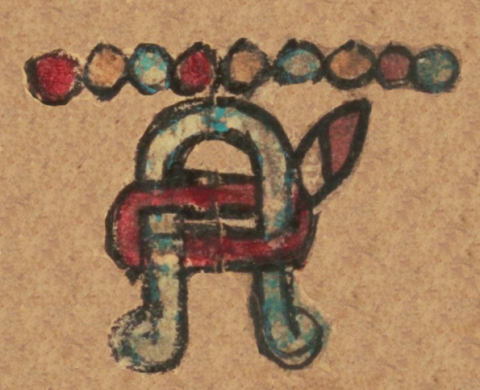Chiucnahui Tecpatl (CQ)
This compound notation-glyph refers to the solar year date Nine Flint Knife (Chiucnahui Tecpatl or Chiucnauhtecpatl). It has the Mixtec A-O glyph for year (xihuitl), being pierced by the flint (tecpatl), and a horizontal row of nine ones in the form of small, colored circles. The A is turquoise blue and the horizontal O is red. The tecpatl, at an angle, is divided into two parts on a diagonal; the upper part is red, and the lower part is white. The ones are painted (L-R), red, yellow, turquoise, red, yellow, turquoise, then yellow, red, turquoise (the latter three breaking what may have been meant as a pattern, intentional or not, it is unclear).
Stephanie Wood
The A-O year glyph suggests a southern Puebla location for the towns mentioned in this manuscript, supported by the presence of towns such as as Huitziltepec, Todos Santos (Xochitlan), and Tochtepec (all located between Puebla and Tehuacan). As found in other examples of the flint knife, the tecpatl is often red and white. Perhaps the red implies blood and sacrificial offerings.
A study of the Codex Quetzalecatzin made by Sebastián van Doesburg notes that the year Chiucnahui Tecpatl (Nine Flint Knife) is associated with the start of the rule of Chicuace Olin (Six Movement) and Matlactli Omei Mazatl (Thirteen Deer), plus a second wife. This long period of rule began in 1528 and ended in Chicuace Tecpatl (1564). [See the citation for van Doesburg's study in our Bibliography, and see pp. 132, 135.]
Stephanie Wood
covers ruling men and women of Tecamachalco through 1593
Stephanie Wood
five, cinco, numbers, números, flint knives, cuchillos de obsidiana, xiuhpohualli, año, turquesa, xihuitl

chiucnahui, nine, https://nahuatl.wired-humanities.org/content/chiucnahui
tecpa(tl), reed, reed-arrow, https://nahuatl.wired-humanities.org/content/tecpatl
Nueve Pedernal, 9-Pedernal
Ofelia Cruz Morales
The Codex Quetzalecatzin, aka Mapa de Ecatepec-Huitziltepec, Codex Ehecatepec-Huitziltepec, or Charles Ratton Codex. Library of Congress. https://www.loc.gov/item/2017590521/
The Library of Congress, current custodian of this pictorial Mexican manuscript, hosts a digital version online. It is not copyright protected.



